研究生跨文化交际翻译
跨文化交际李成明unit2-A原文+翻译PDF

Unit 2With the amazingly rapid development in transportation and information communication, people from different cultures interact more often than ever before, but misunderstandings even conflicts caused in the process of this interaction also grow increasingly. Just for this reason, much concern is focused upon the problem of how to help people interact and communicate successfully in a transcultural way. As a matter of fact, culture is not strange to us all. We hear, read and talk of it, such as Chinese culture, English culture, tea culture, campus culture and so on. But when it comes to the meaning of culture, it is notoriously difficult to define what culture really is or should be.随着交通运输和信息交流的飞速发展,不同文化背景下的人们交往越来越频繁,但在交往过程中产生的误会甚至冲突也日益增多。
正因为如此,人们关注的焦点是如何帮助人们以跨文化的方式成功地进行互动和交流。
事实上,文化对我们大家来说并不陌生。
我们听、读、谈它,如中国文化、英国文化、茶文化、校园文化等。
跨文化交际李成明unit2-A原文+翻译DOCX
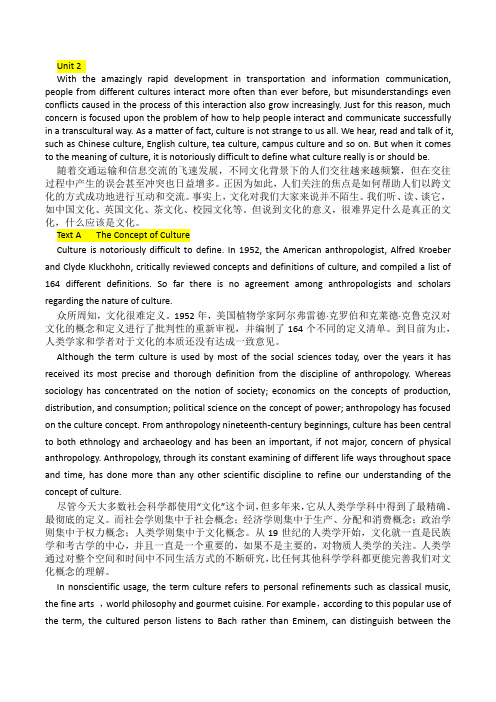
Unit 2With the amazingly rapid development in transportation and information communication, people from different cultures interact more often than ever before, but misunderstandings even conflicts caused in the process of this interaction also grow increasingly. Just for this reason, much concern is focused upon the problem of how to help people interact and communicate successfully in a transcultural way. As a matter of fact, culture is not strange to us all. We hear, read and talk of it, such as Chinese culture, English culture, tea culture, campus culture and so on. But when it comes to the meaning of culture, it is notoriously difficult to define what culture really is or should be.随着交通运输和信息交流的飞速发展,不同文化背景下的人们交往越来越频繁,但在交往过程中产生的误会甚至冲突也日益增多。
正因为如此,人们关注的焦点是如何帮助人们以跨文化的方式成功地进行互动和交流。
事实上,文化对我们大家来说并不陌生。
我们听、读、谈它,如中国文化、英国文化、茶文化、校园文化等。
新编跨文化交际【warm up】 原文及翻译
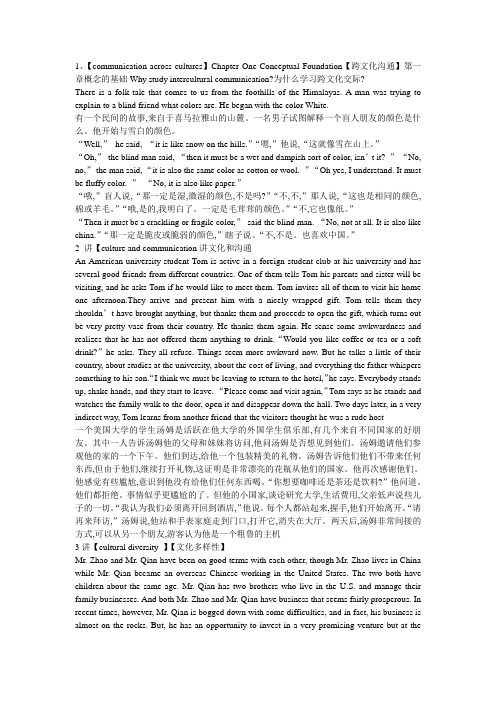
1、【communication across cultures】Chapter One Conceptual Foundation【跨文化沟通】第一章概念的基础Why study intercultural communication?为什么学习跨文化交际?There is a folk tale that comes to us from the foothills of the Himalayas. A man was trying to explain to a blind friend what colors are. He began with the color White.有一个民间的故事,来自于喜马拉雅山的山麓。
一名男子试图解释一个盲人朋友的颜色是什么。
他开始与雪白的颜色。
“Well,”he said, “it is like snow on the hills.”“嗯,”他说,“这就像雪在山上。
”“Oh,”the blind man said, “then it must be a wet and dampish sort of color, isn’t it? ”“No, no,”the man said, “it is also the same color as cotton or wool. ”“Oh yes, I understand. It must be fluffy color. ”“No, it is also like paper.”“哦,”盲人说,“那一定是湿,微湿的颜色,不是吗?”“不,不,”那人说,“这也是相同的颜色,棉或羊毛。
”“哦,是的,我明白了。
一定是毛茸茸的颜色。
”“不,它也像纸。
”“Then it must be a crackling or fragile color,”said the blind man. “No, not at all. It is also like china.”“那一定是脆皮或脆弱的颜色,”瞎子说。
跨文化交际Chapter 1部分翻译
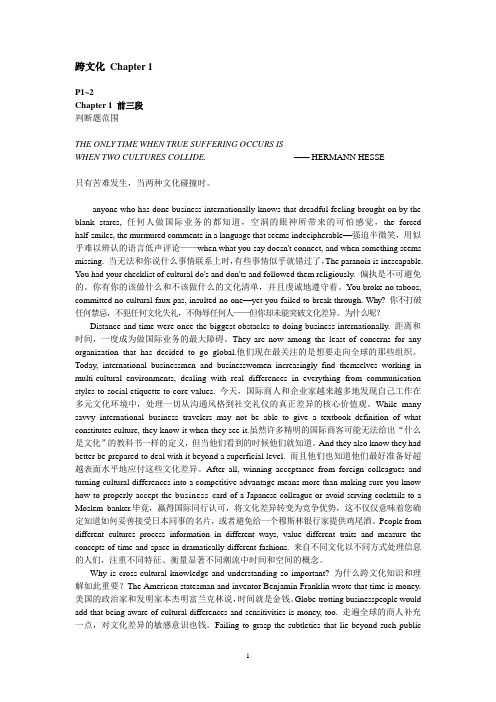
跨文化Chapter 1P1~2Chapter 1 前三段判断题范围THE ONLY TIME WHEN TRUE SUFFERING OCCURS ISWHEN TWO CULTURES COLLIDE. —— HERMANN HESSE只有苦难发生,当两种文化碰撞时。
anyone who has done business internationally knows that dreadful feeling brought on by the blank stares,任何人做国际业务的都知道,空洞的眼神所带来的可怕感觉,the forced half-smiles, the murmured comments in a language that seems indecipherable—强迫半微笑,用似乎难以辨认的语言低声评论——when what you say doesn't connect, and when something seems missing.当无法和你说什么事情联系上时,有些事情似乎就错过了,The paranoia is inescapable. You had your checklist of cultural do's and don'ts and followed them religiously.偏执是不可避免的。
你有你的该做什么和不该做什么的文化清单,并且虔诚地遵守着。
You broke no taboos, committed no cultural faux pas, insulted no one—yet you failed to break through. Why?你不打破任何禁忌,不犯任何文化失礼,不侮辱任何人——但你却未能突破文化差异。
为什么呢?Distance and time were once the biggest obstacles to doing business internationally.距离和时间,一度成为做国际业务的最大障碍。
跨文化交际英语阅读教程课文翻译

跨文化交际英语-阅读教程课文翻译———————————————————————————————————————————————————————————————— 作者作者: : ———————————————————————————————————————————————————————————————— 日期日期: :第一单元现代社会依赖于技术创新现代社会依赖于技术创新,,而技术创新须依靠知识产权来保障。
越来越多的国家遵守国际条约,越来越多的国家遵守国际条约,实行知识产权保护。
实行知识产权保护。
但这方面做得还远远不够。
我们来回顾一下过去,看看缺乏知识产权保护会导致什么样的后果样的后果,,从而吸取教训。
许多西方公司付出了惨痛的代价才发现,知识产权保障机制还未健全时健全时,,在东南亚投资无异于将钱付诸东流。
要进入这些市场,西方公司不仅必须向相关当局说明他们的产品公司不仅必须向相关当局说明他们的产品,,而且还要说明他们产品的制作过程。
而结果经常是本该受到知识产权保护的产品很快被无耻地抄袭。
盗用知识产权的例子不胜枚举。
盗用知识产权的例子不胜枚举。
例如,例如,美国化学制品巨头杜邦向一亚洲国家引进了一种名叫 Londax 的著名除草剂的著名除草剂,,用来除掉稻田里的杂草。
该公司在该产品的研发上投资了数百万美元,该公司在该产品的研发上投资了数百万美元,而且又投入了而且又投入了2500万美元在当地开设了一家生产厂家。
然而,不到一年以后,一瓶瓶非常廉价的冒牌 Lond ax公然上市了。
冒牌产品和正宗产品除了价格外的唯一区别是冒牌产品的名称是Ron dex ,用的是蓝色瓶而不是正宗产品用的绿色瓶。
瓶而不是正宗产品用的绿色瓶。
但是,但是,由于冒牌产品的价格比正宗产品的价格低廉许多,它成功毁掉了杜邦公司的投资。
它成功毁掉了杜邦公司的投资。
同时它也使得该同时它也使得该公司不再愿意投资于新化学制品的研发。
生产Lon dax 的配方本应该被当作是杜邦公司的知识产权。
跨文化交际与翻译-

Intercultural Communication and Translation of Culture-loaded Words of the West and EastAbstract:As a new marginal discipline, intercultural communication became an important separate discipline in the 1970s. It emerged in America and has been developing quickly and greatly in the western world. While in China, the discipline was first introduced in the 1980s. Nowadays, with the increasing exchange of the West and East, intercultural communication becomes increasingly frequent against the background of economic globalization. So it needs corresponding more translation activities. Against the background of economic globalization, we should be fully aware of intercultural communication, especially the conflicts and exchanges between Western and Eastern, the mixture of both and the work of translation. We should both learn the essence of Western culture and keep up the splendid cultural tradition of China.In the course of the intercultural translation, culture-loaded words contain cultural connotation and mirror cultural characteristics, so they are often considered difficult to translate. This thesis studies approaches of translating culture-loaded words in the broad context of intercultural communication by exploring the relation between culture and translation. This thesis argues that by adopting proper translating approaches, culture-loaded words should achieve both semantic and pragmatic equivalence, or at least pragmatic equivalence.Key words: intercultural communication; translation; culture-loaded words; semantic equivalence; pragmatic equivalenceIntroductionIntercultural communication involves two different cultures, and different culture created a different national language. Culture plays an important role in specific semantic structure and model of language. The vocabulary is the accumulation of cultural information, and the cultural concepts and values of different nation at all levels of culture are "reflected in their vocabulary system, and then form the words with cultural connotation." [1]With special cultural connotation, cultural words are often difficult in cross-cultural communication translation, and even become an obstacle to transmission of information.Influence of culture on translationFrom the perspective of intercultural communication, one of the purposes is to establish the cultural equivalence between the source language and target language. In terms of the translation of cultural terms, the cultural equivalence mainly reflects in the semantic equivalence and pragmatic equivalence. Semantic equivalence is the basis of pragmatic equivalence. Thus, in many cases, equivalent translation is also mainly refers to the semantic equivalence.The author believes that the basic principles of cultural lexicon translation should be done to maximize the semantic and pragmatic equivalence. We should at least ensure the pragmatic equivalence if semantic equivalence can not be achieved. For instance, in Tianjin city of China, there is a century-old snack "Goubuli" steamed buns, and now many tourist cities in the country establish its branches, and the buns are also soldabroad. Its English translation "Dog Won't Leave" is far from its original Chinese name meaning. And there is no semantic equivalent at all, because the Chinese "dog ignore" have no contact with “the dog” and “leave”. However, from the perspective of pragmatic translation, “Dog Won't Leave” is a wonderful translation. Dogs won’t leave buns stands for it will not leave its host either. Undoubtedly, such translation has a strong attraction force for diners in English and America who love dogs like loving friends. Basically, the equivalence in pragmatic effects is achieved.As the source language and target language are different in language and culture, it is almost impossible to achieve totally equivalence in semantic and pragmatic aspect for the source language and target language symbols. Therefore, when translating cultural words, we only try to pursuit of semantic equivalence as far as possible under the premise of ensuring pragmatic equivalence. There are five commonly used methods when translating cultural words:First, shift translation. It refers to unchanged moving all or part of the source language to the target language. For instances, CD, VCD, DVD, DNA, ICU, and many computer terms which are translated into Chinese by the shift frequently appear on Chinese newspapers and magazines. Some expressions with Chinese characteristics like qigong (qigong), taijiquan (shadow boxing), jiaozi (dumplings), qipao (cheongsam), has moved in English and American newspapers.Second, transliteration. Some of the source language culture-specific images are "blank" or "vacant” in the target language. I n this case, we can transplant these unique to the target language using transliteration method. Transliteration is homophonic inChinese words or word combinations in English translation, and these words or word combinations are not meaningful ready-made words in Chinese. For instance: 秀(show), 酷(cool), 黑客(hacker), 艾滋病(AIDS), 色拉(salad), 可口可乐(Coca-cola) and so on.Third, literal translation. Literal translation refers to translation of the "corresponding" phrase and cultural information in the source language. This can preserve cultural identity of the source language as much as possible and broaden the cultural horizons of target language readers. However, it can not be applied mechanically, and it should not mislead the reader of the target language. For instance: olive branch (橄榄树), lonely as a cloud (像一朵孤云), 纸老虎(paper tiger),一国两制(one country with two systems), etc.Four, free translation. It focuses on the translation to convey the original meaning (interpretation), which lay down the language form and literal meaning of the source language. It expresses the cultural information of source language in the target language with cross-cultural "pragmatic equivalence. For instance: the Renaissance (文艺复兴); "辛亥革命"(the 1911 Revolution against Qing Dynasty), etc.Five, Replacement. It refers to the replacement of original words with some similar meaning but different concept meaning in the target language on the basis of keeping communication meaning of the original. That is to replace words with rich cultural connotation in the source language with corresponding word with same cultural connotation in the target language. Such as: to laugh off one's head (笑掉大牙); lead a dog's life (过着牛马不如的生活); 挥金如土(to spend money like water); 力大如牛(asstrong as a horse).ConclusionEnglish and Chinese are two different languages, and both reflect the cultural differences which form the barrier of communication. How to overcome obstacles and achieve cultural equivalence is a difficult problem to solve. Practice shows that in most cases we can find reasonable translation methods which can be accepted by readers in the target language. By means of the necessary modifications, we can at least achieve pragmatic equivalence. The important thing is that the translators should attach great importance to cultural factors in the source language, and consider issues from the purpose of intercultural communication.。
翻译研究之2:跨文化交际—翻译理论与对比篇章语言学(Basil Hatim)

COMMUNICATION ACROSS CULTURES Translation Theory and Contrastive Text Linguistics跨文化交际----翻译理论与对比篇章语言学Basil Hatim出版前言这是一部将对比语言学、篇章语言学和翻译理论结合起来研究跨文化交际的学术专著。
作者巴兹尔•哈蒂姆是英国爱丁堡赫利奥特----沃特(Heriot-Watt)大学阿拉伯语研究中心主任,篇章语言学界的权威人士、著名理论家,一直走在该研究领域的前列。
本书是他长达10年的科研成果。
针对目前翻译理论、对比语言学、话语分析三个学科自成一体的学术局面,作者试图将三者融会贯通,明确提出在跨语言、跨文化的交际过程中,如果将母语语言、修辞的习惯表达应用与篇章转化,比如翻译实践当中,并在另一语言体系寻求对应表现法,其结果将是大有裨益的。
本专著共分17章。
全书说理透彻,脉络清晰。
首先,作者简单介绍了对比语言理论应用于翻译过程的可行性,即句法与语义性质等语言结构的重要意义,指出文本类型是进行上下文分析研究的中心课题,篇章才是有效信息交流的根本单位;进而,作者从功能语言学的角度,对修辞、文本风格、语域等因素进行了深入讨论。
由于阿拉伯语具有悠久独特的修辞风格,作者通过现在篇章语言学以及传统的阿拉伯语修辞学在语言研究分析中的有利地位,对篇章类型提出了自己的见解。
除此以外,作者还就文本类型、礼貌表达、交际文化、文学作品中的意识形态的分析与翻译、非小说类的散文文学中反语用法的翻译以及口译研究等问题从对比篇章语言学的角度进行了系统化的分析探讨。
本书贯穿书中的指导思想,就是将语篇分析的理论模型应用于笔译、口译及语言教学实践之中,并通过这些目标在实际中的结合来证明翻译的介绍可以加大对比语言学和语篇分析研究的广度和深度。
总之,本书论述系统全面,资料翔实,从理论到实践环环相扣,是一部侧重语言实际运用的学术著作,对于从事语言学、文学理论、话语分析、翻译以及文化等学科研究的人员提供了建设性的知道,是一本不可多得的好书。
跨文化交际课文翻译

关于跨文化交流,跨文化市场才是第一的真正的首要的范本。
考虑到古罗马帝国的市民,他们是第一个诞生商店的地球文明。
商人们通过在商店的上面树立旗帜来展示他们商品货物的图片来解决跨文化市场的困扰。
这种做法不仅能为罗马帝国中未受过教育的市民服务还能帮助罗马商人们获得被他们用武力征服的殖民地的商业信息。
回顾过去,我们会发现两千多年前的亚里士多德曾明确说过:“有效劝服基本的信念仍可以把他应用到今天的买卖商品上然而在古代的雅典可能会引起一场大的争论”。
很明显的可以看出,交流是现代市场的根基。
毋庸置疑,全球化市场的时代已经到来。
每年超过4万件的商品货物进入国际市场,其中超过一半是来自美国。
这里面85%的商品都不合格。
通往国际化市场成功的道路是建立在失败的市场垃圾碎片和广泛的广告活动之上的。
他们中的大多数之所以会失败,是因为跨文化交流被曲解了。
在跨文化市场里,如果你想把低劣的语言举止降低到最小,那么就不假定任何事情。
几乎我们都听说过关于美国通用汽车公司,他们尽力想把他们的雪佛兰牌汽车销往拉美国家。
但是雪佛兰在说西班牙语的拉美国家按字面意思是不能行走。
当公司发现汽车买不出去的原因时,他们就把车重新命名,然后销往这些国家。
福特汽车公司,美国又一个汽车界的领头羊,也有类似的问题。
他们的pinto 牌汽车在当地也没有达到预期的销售,原因时他们的汽车其意思在当地为男性生殖器。
最终福特公司把所有的名牌汽车重新命名为corcel,其意思为骏马。
伊莱克斯,一个日用电器制造者,其在英国获得了很大的成功。
不幸的是,他们的广告招牌的意思在美国和英国大不相同。
在美国,suck的意思是多虱子的。
英国的牙膏生产商在法国制造出来了一种牙膏叫cue。
它被人们所耻笑。
因为它的名字使人想起了臭名昭著的色情杂志——Cue。
但是市场中的文化意识更多于细心的翻译。
每一文化都有其微妙之处,当然也有其鲜明的禁忌。
尽管大多数的人不能列出他们自己文化的规则,但是他们很明白什么时候这些禁忌被触碰了。
跨文化交际_Unit_2_参考翻译

Unit Two Task 11)A smooth sea never made a skillful mariner. 平静的大海决不能造就出熟练的水手。
/花盆里生长不出参天大树。
/温室里长不出栋梁之才。
2)He who would search for pearls must dive below.不入虎穴,焉得虎子。
/ 欲寻珍珠就要潜到水里。
/ 欲寻珍珠欲潜入水。
3)Living without an aim is like sailing without a compass. 生活没有目标如同航行没有罗盘。
/没有目标的生活如同没有罗盘的航行。
4)To have another fish to fry另有要事/ 另有事情得做5)The water that bears the boat is the same that swallows it up.水能载舟,亦能覆舟。
(The same knife cuts bread and fingers.)6)前人栽树,后人乘凉。
One sows and another reaps. / One man sows and another reaps. / One generation plants the trees in whose shade another generation rests. / The precedence planted, the later generations enjoy its cool.7)斩草不除根,逢春又发青。
If the grass is only cut, then the next spring it will revive. / Cut weeds and dig up the roots.8)种田不用问,深耕多上粪。
Planting has no better measures but ploughing deeply and fertilizing much more.9)生米煮成熟饭。
新编跨文化交际英语教程1~7单元翻译

Unit 2 Page 60 Unit 3 Page 96Unit 5 Page 175 Unit 6 Page 215Case 2A common cultural misunderstanding in classes involves conflicts between what is said to be direct communication style and indirect communication style. In American culture, people tend to say what is on their minds and to mean what they say. Therefore, students in class are expected to ask questions when they need clarification. Mexican culture shares this preference of style with American culture in some situations, and that‘s why the students from Mexico readily adopted the techniques of asking questions in class. However, Korean people generally prefer indirect communication style, and therefore they tend to not say what is on their minds and to rely more on implications and inference, so as to be polite and respectful and avoid losing face through any improper verbal behavior. As is mentioned in the case, to many Koreans, numerous questions would show a disrespect for the teacher, and would also reflect that the student has not studied hard enough.Case 3The conflict here is a difference in cultural values and beliefs. In the beginning, Mary didn’t realize that her Dominican sister saw her as a member of the family, literally. In the Dominican view, family possessions are shared by everyone of the family. Luz was acting as most Dominican sisters would do in borrowing without asking every time. Once Mary understood that there was a different way of looking at this, she would become more accepting. However, she might still experience the same frustration when this happened again. She had to find ways to cope with her own emotional cultural reaction as well as her practical problem (the batteries running out).Case 6When a speaker says something to a hearer, there are at least three kinds ofmeanings involved: utterance meaning, speaker’s meaning and hearer’s meaning. In the dialogue, when Litz said ‘How long is she going to stay?’ she meant to say that if she knew how long her mother-in-law was going to stay in Finland, she would be able to make proper arrangements for her, such as taking her out to do some sightseeing. However, her mother-in-law overheard the conversation, and took Litz’s question to mean “Litz does not want me to stay for long”. From the Chinese point of view, it seems to be inappropriate for Litz to ask such a question just two days after her mother-in-law’s arrival. If she feels she has to ask the question, it would be better to ask some time later and she should not let her mother-in-law hear it.Case 7Keiko insists on giving valuable gifts to her college friends, because in countries like Japan, exchanging gifts is a strongly rooted social tradition. Should you receive a gift, and don’t have one to offer in return, you will probably create a crisis. If not as serious as a crisis, one who doesn’t offer a gift in return may be considered rude or impolite. Therefore, in Japan, gifts are a symbolic way to show appreciation, respect, gratitude and further relationship.Keiko obviously has taken those used items from Mary, Ed and Marion as gifts, for she probably doesn’t know that Americans frequently donate their used household items to church or to the community. Mary, Ed and Marion would never consider those used household items given to Keiko as gifts. No wonder they felt very uncomfortable when they received valuable gifts in return.Case 10In Japan, a company is often very much like a big family, in which the manger(s) will take good care of the employees and the employees are expected to devote themselves to the development of the company and, if it is necessary, to sacrifice their own individual interests for the interests of the company, from which, in the long run, the employees will benefit greatly. But for the French, a company is just a loosely- knit social organization wherein individuals are supposed to take care of themselves and their families. Moreover, the way the French make decisions in the family might also be different from the typical Japanese one, which may not often involve females and the power to decide usually lies with the dominating male. As there are such cultural differences between the Japanese and the French, Mr. Legrand’s decision made Mr. Tanaka feel dumbfounded.Case 12In this case, it seems that the Chinese expectations were not fulfilled. First, having two people sharing host responsibilities could be somewhat confusing to the hierarchically minded Chinese. Second, because age is often viewed as an indication of seniority, the Chinese might have considered the youth of their Canadian hosts as slight to their own status. Third, in China, it is traditional for the host to offer a welcome toast at the beginning of the meal, which is the reciprocated by the guests; by not doing so, the Canadian might be thought rude. The abrupt departure of the Chinese following the banquet was probably an indication that they were not pleased with the way they were treated. The Canadians’ lack of understanding of the Chinese culture and the Chinese ways of communication clearly cost them in their business dealings with the visiting delegation.Case 17When these two men separate, they may leave each other with very different impressions.Mr Richardson is very pleased to have made the acquaintance of Mr Chu and feels they have gotten off to a very good start. They have established their relationship on a first-name basis and Mr Chu’s smile seemed to indicate that he will be friendly and easy to do business with. Mr Richardson is particularly pleased that he had treated Mr Chu with respect for his Chinese background by calling him Hon-fai rather than using the western name, David, which seemed to him an unnecessary imposition of western culture.In contrast, Mr Chu feels quite uncomfortable with Mr Richardson. He feels it will be difficult to work with him, and that Mr Richardson might be rather insensitive to cultural differences. He is particularly bothered that, instead of calling him David or Mr Chu, Mr Richardson used his given name, Hon-fai, the name rarely used by anyone, in fact. It was this embarrassment which caused him to smile. He would feel more comfortable if they called each other Mr Chu and Mr Richardson. Nevertheless, when he was away at school in North America he learned that Americans feel uncomfortable calling people Mr for any extended period of time. His solution was to adopt a western name. He chose David for use in such situations.Case 19Talking about what’s wrong is not easy for people in any culture, but people in high-context countries like China put high priority on keeping harmony, preventing anyone from losing face, and nurturing the relationship. It seems that Ron Kelly had to learn a different way of sending message when he was in China. At home in Canada he would have gone directly to the point. But in China, going directly to the problem with someone may suggest that he or she has failed to live up to his or her responsibility and the honor of his or her organization is in question. In high-context cultures like China, such a message is serious and damaging. In low-context cultures, however, the tendency is just to “spit it out”, to get it into words and worry about the result later. Senders of unwelcome messages use objective facts, assuming, as with persuasion, that facts are neutral, instrumental, and impersonal. Indirectness is often the way members of high-context cultures choose to communicate about a problem. Case 21Sometimes our best intentions can lead to breakdowns (故障)in cross-cultural communication. For example, one of the very common manners of touching --- handshaking --- may result in conflict when performed with no consideration of cultural differences. Among middle-class North American men, it is customary to shake hands as a gesture of friendship. When wanting to communicate extra friendliness, a male in the United States may, while shaking hands, grasp with his left hand his friend’s right arm. However, to people of Middle Eastern countries, the left hand is profane (亵渎的) and touching someone with it is highly offensive. Therefore, in Vernon’s eyes, Kenneth was actually an extremely offensive message to him. Case 22In Puerto Rican culture, as in some other Latin American and Eastern cultures, it is not right for a child to keep an eye-contact with an adult who is accusing him or her, while in the United States, failing of meeting other person’s eye accusing him or her would be taken as a sign of guiltiness. As the principal knew little about this cultural difference in using eye-contact, he decided that the girl must be guilty. Generallyspeaking, avoiding eye-contact with the other(s) is often considered as an insult in some cultures, but may signify respect for authority and obedience in other cultures. Case 25For people from the American culture and western European cultures, one’s time should be scheduled into segments or compartments which are to be kept discrete from one another. They prefer to do one thing at a time. They will be annoyed when they have made an appointment with somebody, only to find a lot of other things going on at the same time. They don’t like to interrupt others and be interrupted by other while they are doing something. In contrast, people from many other cultures including the Chinese culture are more likely to operate with several people, ideas, or matters simultaneously. They are more easily distracted and subject to interruptions, which they would not usually mind very much. The miscommunication between Katherine and the director can be ascribed to their lack of knowledge about each other’s way of using time.In this case, to the Chinese director as well as many other Chinese people, it is natural to handle the other things which needed to be dealt with immediately. He may have thought that, in this way, he utilized the time best. But to Katherine and most Westerners, it’s quite different. They tend to do things strictly according to their schedule and appointments with others, which is their concept of using time best.高语境交流和低语境交流(由高到低排列)Japanese, Chinese, Korean, African American, Native American, Arab, Greek, Latin,Italian,English,Frech,Amercian,Scandinavian,German,German-Swiss。
mti培养方案
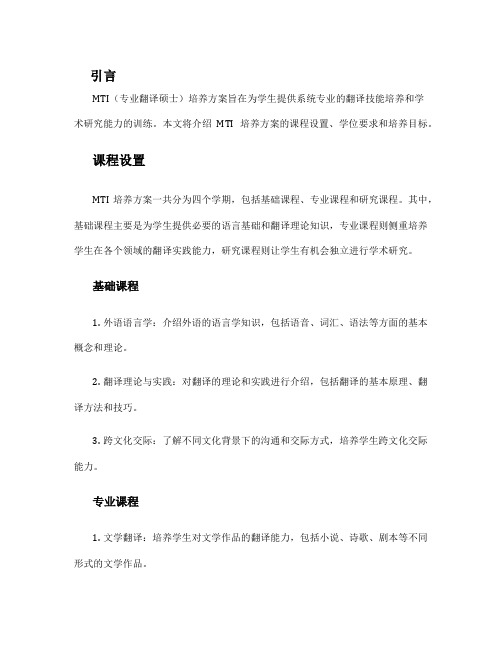
引言MTI(专业翻译硕士)培养方案旨在为学生提供系统专业的翻译技能培养和学术研究能力的训练。
本文将介绍MTI培养方案的课程设置、学位要求和培养目标。
课程设置MTI培养方案一共分为四个学期,包括基础课程、专业课程和研究课程。
其中,基础课程主要是为学生提供必要的语言基础和翻译理论知识,专业课程则侧重培养学生在各个领域的翻译实践能力,研究课程则让学生有机会独立进行学术研究。
基础课程1.外语语言学:介绍外语的语言学知识,包括语音、词汇、语法等方面的基本概念和理论。
2.翻译理论与实践:对翻译的理论和实践进行介绍,包括翻译的基本原理、翻译方法和技巧。
3.跨文化交际:了解不同文化背景下的沟通和交际方式,培养学生跨文化交际能力。
专业课程1.文学翻译:培养学生对文学作品的翻译能力,包括小说、诗歌、剧本等不同形式的文学作品。
2.法律翻译:学习法律领域的专业术语和文书翻译,并了解不同国家的法律体系和法律文化。
3.医学翻译:掌握医学领域的专业知识,能够准确翻译医学文献和临床资料。
4.科技翻译:学习科技领域的专业术语和技术文档翻译,了解科技发展的最新动态。
研究课程1.学术研究方法:培养学生进行学术研究的方法和技能,包括调研、论文撰写等。
2.毕业论文:学生需要在研究导师的指导下独立完成一篇符合学术规范的毕业论文。
学位要求学生需要完成规定的学分,并通过相关考试和评估才能获得MTI学位。
具体学位要求如下:1.学分要求:学生需要获得至少48个学分才能毕业,其中包括必修课程和选修课程。
2.考试要求:学生需要通过各门课程的考试,考试形式包括笔试、口试等。
3.毕业论文:学生需要成功完成一篇符合学术规范的毕业论文,并通过论文答辩才能获得学位。
培养目标MTI培养方案的目标是培养具备国际视野和跨文化交际能力的翻译人才,具体目标包括:1.翻译能力:培养学生运用专业知识和技巧进行翻译的能力,包括对不同领域文本的准确和流畅翻译。
2.语言能力:提升学生的外语水平,使其能够流利地进行口译和笔译工作。
基于跨文化交际视角下的英汉翻译研究
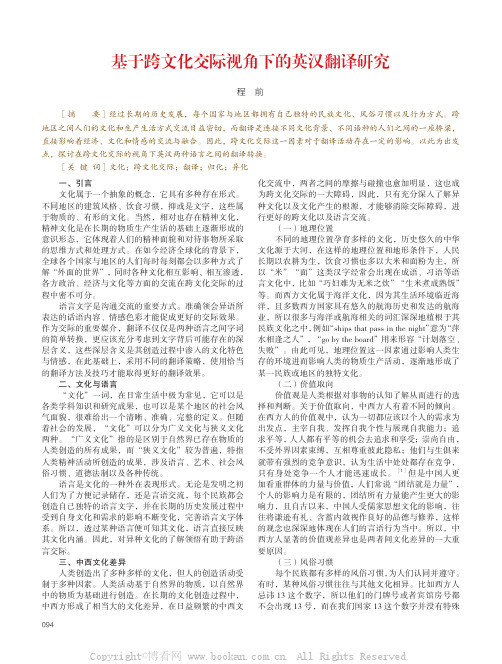
程 前一、引言文化属于一个抽象的概念,它具有多种存在形式。
不同地区的建筑风格、饮食习惯,抑或是文字,这些属于物质的、有形的文化。
当然,相对也存在精神文化,精神文化是在长期的物质生产生活的基础上逐渐形成的意识形态,它体现着人们的精神面貌和对待事物所采取的思维方式和处理方式。
在如今经济全球化的背景下,全球各个国家与地区的人们每时每刻都会以多种方式了解“外面的世界”,同时各种文化相互影响、相互渗透,各方政治、经济与文化等方面的交流在跨文化交际的过程中密不可分。
语言文字是沟通交流的重要方式。
准确领会异语所表达的话语内容、情感色彩才能促成更好的交际效果。
作为交际的重要媒介,翻译不仅仅是两种语言之间字词的简单转换,更应该充分考虑到文字背后可能存在的深层含义,这些深层含义是其创造过程中渗入的文化特色与情感,在此基础上,采用不同的翻译策略,使用恰当的翻译方法及技巧才能取得更好的翻译效果。
二、文化与语言“文化”一词,在日常生活中极为常见,它可以是各类学科知识和研究成果,也可以是某个地区的社会风气面貌,很难给出一个清晰、准确、完整的定义。
但随着社会的发展,“文化”可以分为广义文化与狭义文化两种。
“广义文化”指的是区别于自然界已存在物质的人类创造的所有成果,而“狭义文化”较为普遍,特指人类精神活动所创造的成果,涉及语言、艺术、社会风俗习惯、道德法制以及各种传统。
语言是文化的一种外在表现形式。
无论是发明之初人们为了方便记录储存,还是言语交流,每个民族都会创造自己独特的语言文字,并在长期的历史发展过程中受到自身文化和需求的影响不断变化,完善语言文字体系。
所以,透过某种语言便可知其文化,语言直接反映其文化内涵。
因此,对异种文化的了解领悟有助于跨语言交际。
三、中西文化差异人类创造出了多种多样的文化,但人的创造活动受制于多种因素。
人类活动基于自然界的物质,以自然界中的物质为基础进行创造。
在长期的文化创造过程中,中西方形成了相当大的文化差异,在日益频繁的中西文化交流中,两者之间的摩擦与碰撞也愈加明显,这也成为跨文化交际的一大障碍,因此,只有充分深入了解异种文化以及文化产生的根源,才能够消除交际障碍,进行更好的跨文化以及语言交流。
《跨文化交际与翻译》 (8)
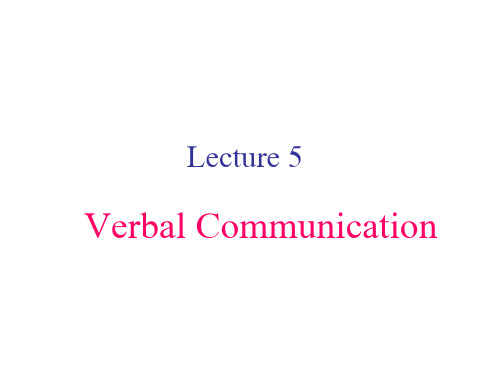
b. The American did not know enough about his company’s products.
c. Starting his presentation with several jokes made the Germans think that he was not very serious about the business.
word can be used once only. (red book p53)
1. When I’m feeling ___, all I have to do is take a look at you, and think of the happy moment we underwent.
Lecture 5
Verbal Communication
Do the following words have the same denotation and connotation?
• parrot • wolf • pig • bee • pigeon • donkey • fox • lamb
“I think Dobbie devoted herself to the post. She is a really white person.”
“A white person?” Wang Fei was surprised, “No, she is from Africa.”
white
esteem color
In one specific context
A bank manager to. a clerk standing in front of the safe box in the morning.
跨文化交际英语阅读教程unit02课后翻译

Checking Is Believing参考译文:验证为实网络随时在拓展,它几乎可以给大多数学科提供无限量的信息。
除了提供大量信息之外,网络使用起来也方便快捷。
如今,我们拥有很多设备它们可以联网并展示信息,即使当你在赶路时也是如此。
因此,网络可以提供一个获取信息的方便途径,而且网络已经受到了学生们的极力推崇。
如果一位学生有条件上网,那么他/她就没有必要去图书馆查找资料。
这样不仅节省了大量的时间也省去了交通费。
几乎可以这样说,学生们比上班族有更多的时间浏览网页,网络上提供的信息有助于他们完成学习任务,这一点成了他们上网的额外动机。
Reading BThis freedom is, of course, in sharp contrast to traditional media. Publishing companies, for example, can be very selective about their authors. Such companies have high standards and will only publish a book if the author is well qualified and experienced in the subject area. Publishers get other experts to review a book before it is printed and further improvements to the book are made by editors and book designers employed by the publishing companies. Editors frequently make suggestions to make the book longer or shorter and to improvethe au thor’s use of language to make the writing clearer and more easily comprehensible to readers. Designers handle the layout of a book, including the cover, photographs and other graphics and even the font type and style of the text.参考译文:网络提供的这种自由和传统的媒介相比当然有着明显的区别。
跨文化交际课文翻译

Speaki ng Englis h with a Japane se mind 日本人在达到上学年龄后就要学英语,这些人在学会英语之后就可能用英语进行对外交流,但是他们所使用的英语要受到他们本民族的语言和文化的影响。
因此这就会造成困扰和误解在与其他用英语的人交流时。
AM,当他作为索尼公司的首席执行官时,在一次给美国的商学会做报告时他指出了这两种语言的明显差异。
他举了一个例子,一个美国商人向他的一个日本生意上的伙伴提议了一项计划。
可是当美国人完成时,日本人才开始谈论这个项目听起来多么有趣并且他们公司也有同样的想法。
美国人认为这个项目肯定会被接受。
但是随着辩论的拖延,美国人的关注也开始减弱,然后日本人说,不管怎样。
AM告诫说,接下来就是你要仔细听的时候了。
因为真正的回答是在那个词语的后面。
他经常告诫他的部下官员要用一种大多数的使用英语的人都习惯的方式说话,如果他想被别人理解。
他还告诫说,在日本你可能是大多数,但是到了国外你就是一小部分。
要想用一种大多数人都能最大限度的理解你的方式说话需要更多的语法知识和大量的词汇。
你必须对你所谈话的那个人的交流方式,社交礼仪,价值观等等很熟悉。
日本人的说话顺序正好和说英语的人相反。
甚至就是一个非常简单的句子,比如英国人会说,你得带伞因为要下雨。
而日本人会说,因为会下雨所以你要带伞。
不管这种正常的表达方式的顺序是否会控制想法顺序还是什么,日本人这种用不同顺序的表达信息的方式会让那些说英语的国家的人且对日本语言不了解的人感到困惑。
另一个例子就是,一些说英语的日本人和美国的一些领导举行卫星电视会议来讨论两国间的经济和贸易关系。
日本的参会者说着流利的英语,同时会被翻译成日语以供那些不懂得英语的人理解。
跨文化交际课后翻译原文1--8单元

Translation1The growth of intercultural communication as a field of study is based on a view of history that clearly demonstrates people and cultures have been troubled by a persistent inability to understand and get along with groups and societies removed by space, ideology, appearance, and behavior from their own. What is intriguing about many of human civilization’s failure is that they appear to be personal as well as global. The story of humankind is punctuated with instances of face-to-face conflicts as well as international misunderstanding--major and minor quarrels that range from simple name-calling to isolationism tr even armed conflict. It is obvious that increases contact with other cultures and subcultures make it imperative for us to make a concerted effort to understand and get along with people whose beliefs and backgrounds may be vastly different from our own. The ability, through increased awareness and understanding, to peacefully coexist with people who do not necessarily share our lifestyles or values could benefit us not only in our own neighborhoods but could be the decisive factor in maintaining would peace. Translation 2Culture is something referred to as our mental programming, our “software of the mind.”But we can take that computer analogy further and say that culture is the operating environment that enables software programs to run. Culture is like DOS or Unix or Windows:it is what enables us to process information in various specific applications. The metaphor of windows seems to be very appealing to describe culture:culture is a mental set of windows through which all of life is viewed. It varies from individual to individual within a society, but it shares important characteristics with members of a society. Culture is like the water fish swim in--a reality that is taken for granted and rarely examined. It is in the air we breathe and is as necessary to our understanding of who we are as air is to our physical life. Culture is the property of a community people, not simply a characteristic of individuals. Societies are programmed by culture, and that programming comes from similar life experiences and similar interpretations of what those experiences mean. If culture is mental programming, it is also a mental map of reality. It tells us from early childhood what matters, what o prefer, what to avoid, and what to do. Culture also tells us what ought to be . It gives us assumptions about the ideal beyond what individuals may experience. It helps us in setting priorities. It establishes codes for behavior and provides justification and legitimization for that behavior.Translation 3Although each of us has a unique set of values, there also are values that tend to permeate a culture. These are called cultural values. Cultural values generally are normative in that they inform a member of a culture what is good and bad, right and false, positive and negative, and the like. Cultural values define what is worthwhile to die for, what is worth protecting, what frightens people and their social systems, what are considered proper subjects for study and for ridicule, and what types of events lead individuals to group solidarity. Cultural values also specify what behaviors are of importance and which should be avoided within a culture. Values represent a learned organization of rules for making choices and for resolving conflicts. The values held by participants in intercultural communication are important because values develop standards and guidelines that establish appropriate and inappropriate behaviors in a society. V alues, in other words, help determine how people ought to behave with the result that people will exhibit and expect behaviors according to their value systems. To the extent that cultural value systems differ, we may expect that intercultural communication participants will tend to exhibit and to expect different under similar circumstance.Translation 4When we say that language is always ambiguous, what we mean is that we can never fully control the meaning of the things we say and write. The meanings we exchange by speaking and by writing are not given in the words and sentences alone but are also constructed partly out of what our listeners and our readers interpret them to mean. To put this quite another way, meaning in language is jointly constructed by the participants in communication. Language is inherently ambiguous. It means that in order to communicate we must always jump to conclusions about what other mean. There is no way around this. When someone says something, w must jump to some conclusion about what he or she means. We draw inferences based on two main sources. 1, the language they have used, and 2, our knowledge about the world. The knowledge includes expectations about what people would normally say in such circumstances. Language is ambiguous. This means that we can never be certain what the other person means--whether in speaking or writing. To put it another way, language can never fully express our meanings. But what does this mean for intercultural communication? In the first place it should be clear that communication works better the more the participants share assumptions and knowledge about the world. Where two people have very similar histories, backgrounds, and experiences, their communication works fairly easily because the inferences each makes about what the other means will be based on common experience and knowledge. Two people from the same village and the same family are likely to make fewer mistakes in drawing inferences about what the other means than two people from different cities on different sides of the earth.Translation 5Where any two people differ in group membership because they are of different genders, different ages, different ethnic or culture groups, different educations, different parts of the same country or even city, different income or occupational groups, or with very different personal histories, each will find it more difficult to draw inferences about what the other person means.In the contemporary world of international and intercultural communication, the differences between people are considerable. People are in daily contact with members of cultures and other groups from all around the world. Successful communication is based on sharing as much as possible the assumptions we make about what others mean. When we are communicating with people who are very different from us, it is very difficult to know how ti draw inferences about what they mean, and so it is impossible to depend on shared knowledge and background for confidence in our interpretation.It has been found that men and women from the same culture, even from the sane families, often misunderstand each other because of different assumptions they make about the purposes or goals of their communication. A man may wish to make a woman happy by giving her a gift of something she really wants. He asks her what she would like to have for her birthday--- she can ask for anything. Unfortunately, what she wants more than anything else is for him to know intuitively what she would like to have. Men and women, at least in North American society, tend to differ in their concern for explicitness or for indirection. A woman is likely to think it is important for someone to show how well he knows her by not having to ask explicitly what she wants. A man in that situation, however, feels beast about the situation if he is told quiet directly and explicitly how he can make her happy.Translation 6Non-verbal communication might be thought of as any form of communication which is not directly dependent on the use of language. Generally speaking, however, it is very difficult to know where to separate verbal and non-verbal forms of communication. Such non-verbal aspects of communication as nodding the head most often accompany speech and are part and parcel of the verbal system of language use. On the other hand such forms of communication as dance and music often have no verbal component at all. What we want to here is simply to call attention to the fact that many aspects of human interaction depend upon forms of communication which can not be easily transcribed into words and yet are crucial to our understanding to each other.Of course we have to emphasize the importance of communication in speaking and writing, and yet we should also realize that much much communication also takes place without the use of words. The way a person dresses for a meeting may suggestion to other participants how he or she is prepared to participate in it. In fact, we can use virtually any aspect of our behavior or our presentation which others can perceive as means of communication.Translation 7Many people today want to do many things within so little time. The sense o time might be called time urgency, it is a syndrome of behavior in which the persons continually tries to accomplish more than can be humanly accomplished. Until very recently, time urgency was thought to be a characteristics of Americans, particularly American males in the generation born in the period from the Great Depression through to the end of the World War .It should be obvious that that this sense of time urgency is no longer a cultural characteristic of just this one generation of American males. It is a characteristic of the Asian “salary man”, and is spreading throughout the world rapidly as one aspect of the internationalization of business.One of the most important effects of this sense of time is that in communication it will almost produce a negative evaluation to the slower participants by the faster participants. Those who share in this concept of time urgency will come to see anyone who moves more slowly than they do as conservative, as uncooperative, as resistant to change, and as opposing progress. Behind the concept of time urgency is the idea that what lies ahead in the future is always better than what lies behind in the past; it based solidly on the belief in progress.Translation 8If we accept the belief that our past influences our view of reality and the corresponding tenet that each of us may have similar but not identical personal histories, then it should follow that another person’s picture of the universe will not be exactly like ours. Y et most of us act as if our way of perceiving things is the correct and only way. We often overwork perceptual differences and conclude that if the other person doesn’t see that Pablo Picasso is the greatest artist that ever lived, he simply does not art. Actually, it may well be that he has a different past history and what is great art for him may not match our perception of art.In our daily activities these differences in perception appear between different groups. V arious generations, minorities, occupation and cultures have conflicting values and goals that will influence their orientation and interpretation of reality.Our culture is a major of factor in perceptual discrepancies. Culture helps supply us with our perceptive of reality. It therefore plays a dominant role in intercultural communication. Our cultures tell us, in a variety of ways, how to judge others and what to use as criteria for those judgments. The danger of such evaluations is that they are often false, misleading, and arbitrary. It is truly a naive view of the world to believe and behave as if we an our culture have discovered the true and only set of norms.。
新编跨文化交际英语教程1-6单元翻译(Word可编辑版)

纵观历史,我们可以清楚地看到,人们由于彼此所处地域、意识形态、容貌服饰和行为举止上存在的差异,而长久无法互相理解、无法和睦相处。
在这种情况下,跨文化交际作为一个特定的研究领域得以形成和发展。
值得注意的是, 人类文明在发展过程中所遭受的许多挫折, 既是个人的, 又是全球性的: 人类历史进程总是充满了个人问的直接冲突和民族间的误解一一从骂骂咧咧到孤立主义直至到武装冲突, 大大小小争端不绝。
很显然, 文化间以及亚文化问的交往比以前多了, 这迫切要求我们共同努力, 去理解有着不同信仰和文化背景的人们, 并与之和睦相处。
通过加深认识和理解, 我们能够与生活方式、价值观念不同的人们和平共处: 这不但有益于我们周遭环境的安定, 也是维护世界和平的决定性因素。
Translation Unit 2文化有时候被称为我们的心智程序, 我们“头脑的软件”。
但是, 我们可以进一步引中这个用电脑所做的类比, 把文化看作是支持运行的操作环境。
文化就像电脑使用的Dos 或者unix 或者“视窗”(windows) 等操作系统一样, 使我们能在各种各样的实际应用中处理信息。
用“视窗”这个比喻来描述文化似乎也很有吸引力。
文化就是我们心灵的视窗,透过它我们审视生活的方方面面。
一个社会中不同个体的视窗是不大一样的, 但都有着一些重要的共同特征。
文化就好像是鱼畅游于其中的水一般, 人们想当然地把文化看成是客观存在的事实, 因而很少去研究它。
文化存在于我们所呼吸的空气之中, 文化对于我们了解我们自身之为何物是必不可少的, 就正如生命离不开空气一样。
文化是特定群体的共有财产, 而不单是个体的特征。
社会按照文化设定的程序运作, 这种程序来自于相似的生活体验以及对这种生活体验之含义的相似阐释。
如果文化是一种心智程序, 那么它也是现实的心灵地图。
从我们很小的时候开始, 文化就告诉我们应该看重什么、偏好什么、规避什么和做些什么, 文化还告诉我们事物应该是什么样。
跨文化交际(胡超版)-判断题及翻译

跨文化交际实用教程判断题与翻译Unit 1T 1 As a phenomenon, intercultural communication has existed for thousands of years. However, as a discipline, its history is only about fifty years.作为一种现象,跨文化传播已经存在了数千年.然而,作为一门学科,它的历史只有大约五十年.F 2 Intercultural Communication as a discipline first started in Europe.跨文化交际是欧洲第一门学科F 3 Culture is a static entity< 静态的实体> while communication is a dynamic process.文化是一个静态的实体而沟通是一个动态的过程T 4 Culture can be seen as shared knowledge ,what people need to know in order to act appropriately in a given <约定的特定的> culture.文化可以被看作是一种共享的知识,人们需要知道的是在一个特定的文化中扮演适当的行为T 5 Although cultural stereotype has its limitations<over-generalization>,it still contributes to a person’s cultural cognition.认识、认知文化刻板印象虽有其局限性,但仍有助于人的文化认知.T 6 In intercultural communication, we should separate one’s individual character from cultural generalization.在跨文化交际中,我们要把自己的个性和文化的泛化分开.T 7 Cultural mistakes are more serious than linguistic mistakes. The linguistic mistake means that someone is not fully expressing his or her idea while cultural mistakes can lead to serious misunderstanding and even ill-feeling between individuals.文化错误比语言错误更严重.语言错误意味着有人不能充分表达自己的想法,而文化上的错误会导致严重的误解,甚至个人之间的不适感F 8 All people of the same nationality will have the same culture.所有同一民族的人都会有相同的文化T 9 Although two cultures may share the same ideas, their meaning and significance may not be the same. 虽然两国文化有着相同的想法,但它们的意义和意义可能不一样F 10 One’s actions are totally independent of his or her culture.个人的行为完全独立于他或她的文化Unit 2T 1、All cultures require and value politeness, but the ways in which politeness is achievedmay vary significantly.所有的文化都需要和价值的礼貌,但礼貌的方式可能会有所不同T2、Don’t take offence-getting the form of address 〞wrong〞is rarely intended to be offensive.不要拿"错误〞的形式来攻击,这是很难得的进攻T3、Addressing forms like "Miss Mary〞, 〞Brown〞by the Chinese may be a form of cultural compromise.解决形式如"玛丽小姐〞,"棕色〞由中国可能是一种文化妥协的形式.T4.Ranks in the armed forces like Captain, Colonel can be used as titles.上校,上校,上校,可以用作头衔F5.Westerners can understand what Uncle policeman or P.L.A. Uncle means.西方人能够理解警察叔叔和解放军叔叔的手段.F6.We can address Jason Douglas, who is a lawyer, as Lawyer Douglas.我们可以解决杰森道格拉斯,他是个律师,律师道格拉斯.F7.Chinese hospitality toward the westerners is always greatly appreciated.中国人对西方人的热情好客是非常赞赏的.F8.The Chinese way of showing concern is usually appreciated by the Westerners.西方人对中国人的关注往往受到西方人的赞赏.F_9.〞Thank you for coming!〞is a typical expression used by Western hosts when the guests just arrived. 谢谢你的到来!"当客人刚到的时候,这是西方主人使用的一种典型的表达形式.T10.〞I’m sorry to have wasted your time〞or "I’m sorry to have taken up so much of yourtime〞are usually appropriate for the business visit.我很抱歉浪费了你的时间〞或者"我很抱歉占用了你这么多时间〞,通常都是适合商务拜访的.Unit 3T 1.sometimes the Chinese way of showing modesty may be considered as fishing for compliments.有时,中国人表现出谦虚的方式可以被视为对赞美的赞美T2.The social functions of Chinese and English compliments are roughly the same.汉语和英语的社会功能大致相同.T 3.In informal situations, a large number of compliments are used to make people feel comfortable.在非正式场合,大量的赞美是让人感到舒服的F 4.The cultural assumption of compliments is the same between cultures.文化的假设是文化的相同的.T 5.Adjectives and verbs are often used to convey compliment message in English, while adjectives, adverbs and verbs are often used in Chinese.形容词和动词常被用来传递英语中的恭维话,而形容词、副词和动词常被用在汉语里.F6. English compliments often begin with the word "you〞while Chinese compliments often start with the word "I〞. 英语的赞美常以"你〞一词开头,而中国人的赞美常以"我〞一词开头F 7. Chinese people give more compliments in daily life than Americans.在日常生活中,中国人比美国人更为赞美.F8. Americans tends to be self-effacing in their compliments responses.美国人往往自谦在称赞别人的反应.F9. Compliments on other’s belongings are sometimes an indirect way of request in American culture.对他人财物的赞美有时是美国文化中的一种间接的方式T10. If a guest compliments something in another person’s home, the Chinese host or hostess will probably give that thing to the guest.如果一个客人在别人家里赞美别人的话,中国主人或女主人很可能会把这件事告诉客人.Unit 4F 1.Verbal communication is more important than nonverbal communication.言语交际比非语言交际更为重要F 2."Dragon〞means the same to the Westerner as "龙〞to the Chinese."龙〞是指同为西方人的"龙〞到中国.F 3.The Chinese phrase "知识分子〞has the same meaning as "intellectual〞.中国"知识分子〞具有相同的含义是"知识T 4.A term in one language may not have a counterpart in another language.在一种语言中的一个术语在另一种语言中可能没有对等词F 5.In referring to animals and birds, the Chinese practice is generally, but not always ,to use "公〞or "母〞to show whether a creature is male or female. This is the same with the English language.在谈到动物和鸟类,中国的做法是通常,但不总是,用"公〞或"母〞来表明该生物是否是男性或女性.这与英语是一样的.T 6. The following six English word: "vice〞, "associate〞, "assistant〞, "deputy〞, "lieutenant〞and "under〞can all mean "副〞in Chinese language.以下六个英文单词:"副〞、"联想〞、"助理〞、"副〞、"中尉〞和"下〞都是"副〞在汉语中F 7.There are as many similarities as dissimilarities between English proverbs and Chinese proverbs.有许多相似之处,英语谚语和汉语谚语的异同.T 8. Violating a cultural taboo is as serious as violating a verbal taboo,违反文化禁忌的是严重违背了言语禁忌T 9.Patterns of thought varies with culture.思维方式随文化而变化.T10.Particular thought patterns predominate in each culture, e.g. American culture is predominantlyfactual-inductive, Russian culture is predominantly axiomatic-deductive, and Arab cultures are predominately intuitive-affective.在每一个特定的思维模式主导文化的,例如美国文化主要是事实的归纳,俄罗斯文化主要是公理化演绎,和阿拉伯文化以直观的情感.Unit 5T1.Speaking is just one mode of communication. There are many others.说只是一种交流方式.还有许多人F2.Some researchers assert that in face-to-face communication, about 70%of information is communicated through speaking, and over 30% sis sent by nonverbal means.一些研究者断言,在面对面的交流中,约有70%的信息是通过说话,而超过30%则是通过非语言方式发送的T3.Environment is one of the five study areas that nonverbal communication covers.环境是非语言交际的五个研究领域之一T4.Much of our nonverbal behavior, like culture, tends to elusive, spontaneous and frequently goes beyond our awareness.我们大部分的非语言行为,如文化,往往难以实现,自发的,往往超越我们的认识tin American, African, Arab and most Asian cultures are M-Time cultures.拉丁美洲,非洲,阿拉伯和大多数亚洲文化是单一的文化.T6.Arab belongs to tough cultures.阿拉伯属于艰难的文化T7.In some cultures, eye contact should be avoided in order to show respect or obedience.在一些文化中,为了表示尊重或服从,应该避免使用目光接触T8.The appropriateness of physical contact varies with different cultures.身体接触的适宜性因不同的文化而不同F9.Western women usually like Chinese to touch their bodies or small children.西方妇女通常喜欢中国人接触他们的身体或小孩.F10.Seating arrangements reflect culture. Chinese people tend to talk with those opposite them rather than those seated or standing beside them.座位安排体现文化.中国人倾向于和他们说话,而不是坐在他们旁边的人Unit 6F1.Gender is the cultural meaning of "sex〞.性别是"性〞的文化内涵F2.Sex and gender are synonymous.同义的性别和性别是同义词T3.A lady might be feminine, masculine or a combination of both.一位女士可能是女性,男性或两者的结合T4.Women are generally comfortable with building close relationships and confiding to others, while most men are reserved about involvement and disclosure.女性一般舒适与建筑密切关系和信任别人,而大多数人都保留对参与和披露.F5.Most men use communication to create connection or equality between people.大多数人用沟通来建立联系或平等的人F6.Women usually use communication to establish status and power.女性通常使用沟通来确立地位和权力T7.In feminine culture, communication is a way—probably the primary way—to express and expand closeness.在女性文化中,传播是表达和扩大亲密关系的主要途径.T8.Masculine socialization stresses doing things and regards action as primary ways to create and express closeness.男性社会化强调做事情,把行动视为创造和表达亲密的主要方式.T9.The first and last principal for effective cross-gender communication is suspending judgment.有效的跨性别传播的第一个和最后一个主要是中止判断.T10.It is difficult but possible to seek translation cues that will facilitate our communication.这是困难的,但可能寻求翻译线索,将有利于我们的沟通.跨文化交际实用教程复习总结简单版1、外国人指下星期六是指这个周六,而我们中过人说下星期六是这个星期后的星期六,参照时间点不同2、外国人不喜欢人家说他/她老3、名字顺序:He Xiangu , Andrew LewisSurname given name ,given name Surname注意:surname =last name; given name=first name称呼职称时,中国:surname +title;外国:Title+surname 或Title +surname given name4、副的用法:vice associate assistant deputy under lieutenantEg:vice-chairman , associate proffessor , assistant mananger , deputy director , undersecretary , lieutenant governor5、西方人认为下面的东西是私隐的:age,salary,health,family,visiting〔拜访人家要提前通知〕,parting6、在西方,如果去拜访人家,来到主人家时,客人会被立刻问到要不要脱下大衣〔out-door clothing〕,如果客人说不脱了,表示他们只是stay a few minutes.7、在中国,It is acceptable 留下东西在盘子里,但是在西方,这是不礼貌的,要finish eating.8、In English, only a few titles can be used: Doctor, Judge,Governor, Major,Professor, Nurse, Captain, Colonel.9、西方人可以当面指出朋友的错误,东方人不行.10、加拿大人:No seeing out when Guest leaves.No stand-up when your leaders comes in.No help for old people.11、Positively commenting on somenting can indicate that the speaker like to possess it.所以中国人一听到人家说"I love your scarf,It is really pretty〞赞美她的东西,就会坚持要送给人家.12、中国人赞美的语言特征:以"you〞"your〞开头,西方人则以"I〞开头.13、西方人认为losing weigh is good 中国人不认为good.14、M-time:西方-Northern American,Western and Northern EuropeanP-time:东方-Latin American,Afican,Arab,most Asian15、地中海文化:夸X/大悲痛,经常可以见到男性在公共场合哭.美国:男性压抑情感.日本:男性更加压抑情感,将生气、悲伤、失望用微笑掩埋.韩国:太多的微笑会被认为肤浅.泰国:The land of smiles.16、眼神接触西方人希望有眼神接触,阿拉伯人也同意.日本人、Latin American、加勒比海人不提倡太长时间眼神接触.17、谈话之间美国人不希望有silence,日本人很欣赏silence.18、Body contactAsia、地中海文化可以有同性之间的,但异性之间是禁止的.19、Negotiation日本、中国、中东、巴西、墨西哥认为relationship在negotiaton重要20、美国人见到别人打招呼用first name,也会touch people ,英国人则要熟络之后才用first name.21、英国人有很强的隐私22、西方人通常选择座位:主人指的或他们喜欢的, 中国人认为坐在不是很舒服的位置可显示出谦虚.23、adj. 和V经常被英语用来赞美,adj. adv.和V经常被东方人用来赞美.24、T aboos东西方都是禁忌的:关于排泄物、sexual intercourse and parts of the body、four-letter words、诅咒.25、Thought patterns美国:factual-inductive 事实归纳型Russian:axiomatic-deductive 推论/演绎型Arab:intuitive-affective 直觉/观型26、In Korea,女士如果有社会地位的一般穿dress或skirt,只有地位低得才穿trousers.27、"OK〞gesture:美国means good,Brazil means 下流的,不好的,Japan 和korea means money.28、美国人wil sit with their feet on the desk,which shows 他们舒服,但对于Latin American or Asians,这个行为是粗鲁的和自大傲慢的.29、personal spaceShort distance:Latins,地中海的ArabsMedium distance:Americans,Northern EuropeansLong distance:Japanese,地中海的Europeans30、Seating arrangements美国人:tend to talk with those opposite them rather than those seated or stand beside them.中国人:with people sitting next to each other.31、Point to objects美国人:用index fingerGerman:little fingerJapanese:entire handAsian:用index finger is considered rude.32、Beckoning sign〔示意叫唤〕中国人:By shaking the hand with palm turned downward,对于美国人,这个动作means wave goodbye. 美国人:one palm up,fingers more or less together,and moves toward his or her body.33、Counting with fingersChinese:bending the fingers from a stretcher palmAmerican:stretching the fingers from a cleachen fist.。
- 1、下载文档前请自行甄别文档内容的完整性,平台不提供额外的编辑、内容补充、找答案等附加服务。
- 2、"仅部分预览"的文档,不可在线预览部分如存在完整性等问题,可反馈申请退款(可完整预览的文档不适用该条件!)。
- 3、如文档侵犯您的权益,请联系客服反馈,我们会尽快为您处理(人工客服工作时间:9:00-18:30)。
Lesson 1无论好坏,全球化已经极大地改变了世界。
虽然还处于早期阶段,但它几乎无法阻挡。
人们现在面临的挑战是学习如何与之共存,管理它,利用它提供的好处。
许多人认为,由于全球化,全世界的生产力将得到提升,随着世界变得更加富裕和繁荣,各地的生活水平都有可能上升。
然而,仍然有很多反对者采取相反的观点,声称全球化将对我们的生活产生越来越大的破坏性影响。
双方都可以指出足够的例子来支持他们的观点。
但最终,两者都可能在某种程度上夸大了。
无可辩驳的是,由于全球化,世界经济蛋糕的确变得越来越大-而且它的分配方式也与以前不同。
事实上,全球化对不同的人意味着不同的东西,特别是在涉及就业外包或移民等敏感问题时。
全球化可能创造比实际破坏更多的就业机会,但它们分布在不同的部门和不同的地理区域。
在当今世界,就业需要更多的技能,教育和流动性。
接下来,来自加尔各答的印度作家Sujan Pandit 描述了他是如何陷入全球劳动力市场的几次构造转变之间的。
他还探讨了他的独特情况如何为他提供给少数其他印第安人的选择。
我的命运是不是一个企业步兵型,其中作为电视图像和报纸照片会建议包括劳动力在一个小细胞,并与许多其他同样勤劳蜂蜜的蜜蜂一前一后的生活,只配备有工作站和电话。
我在营销和业务发展方面的工作并没有避免面对面的接触。
我工作的公司很小,但它跨越三个时区:达拉斯,纽约和加尔各答。
但是,这个公司与众不同之处在于它是一家后现代公司,因为十年前这样的公司几乎不可能存在。
这就是卡斯特加州大学伯克利分校城市与区域规划系教授会叫的网络公司,仅通过电子邮件和电话会议一起举行。
走出空调办公室,迎接我的是加尔各答黄昏的炎热和潮湿。
我叫了一辆黑色和黄色相间的出租车,并指示司机前往我的俱乐部。
他是一辆古老的大使车,可追溯到20世纪50年代的莫里斯牛津模仿,并且仍未改变这是全球化前许可拉杰时代的名副其实的纪念碑。
当出租车经过喧嚣和加尔各答的街道的喧嚣中,高音的音乐和花哨电影海报,躲避奶牛和跑腿的人力车夫时,我默想我周围的景象。
我的工作与他们的生活形成鲜明对比!全球化对这些人意味着什么?如果全球化必须对印度穷人意义重大,那就必然意味着改变他们的生活。
然而,我可以打赌,他们的生活会从他们的父亲或祖父辈到他们都没有显著的不同。
我唯一能给自己的安慰是我的工作让我成为运动的先锋,在本世纪的历程中提高自己的曾孙的生活。
最后,出租车到达俱乐部,一个古老的维多利亚式会所在广阔的高尔夫球场,修剪整齐的草坪和网球场之间进入。
我前往茶室。
凭借丹尼尔斯的水彩印花,丰富的织锦椅,深色桃花心木镶板和木制镶嵌,这是下班后享用咖啡的好地方。
一个有钱的服务员带给我一些。
俱乐部本身就是全球化最后时代的产物,Eric Hobsbawm称之为帝国时代”。
现在我们处于全球化的另一个时代,从那时起,装饰似乎没有什么变化。
只有这样,作为印度人,我才不会被允许进入其神圣的门户。
或许有些事情确实会发生变化!喝着咖啡,我在思考英格兰正在讨论的问题:“进口工人还是出口工作?“我首先想到的就是它展现了一个非常第一世界的观点。
坐在第三世界的国家,这个命题同样可以表达为:“出口工人或进口工作?”其实,你的国家,它无论怎样,经济学家的答案是一样的,是非常简单的:不要紧。
作为经济学的研究生,我曾吸收微观经济学的定理几乎就像我吸收母亲的乳汁。
如果我们将工作权和公民权视为一揽子合法权利,那么他们的自由交换将把资源转移到最高价值的用途,从而最大限度地提高全球产出。
在这种情况下,迁移和外包是同一个硬币的两面,暂时的不平衡条件导致最终的均衡。
一个令人钦佩的目标?确实!可实现的?它将创建人性的弱点。
只要它不影响我自己的生活方式,全世界同等工作的平等实际工资是最令人满意的。
平等是好的,我可以免受其压力。
由于一种奇怪的命运,我不得不从两个方面来看移民和外包的问题。
作为印度父亲和英国母亲的孩子,我有印度公民身份,但也有居留权,允许我在英国工作。
同时,我是美国绿卡的申请人。
我的高等教育大部分发生在美国,我曾在印度,英国和美国工作过。
作为一个国家的真正公民,我同时保留了另外两个国家的公民的权利。
在三个国家之间转换的我,有理由为印度在工作外包方面的成功而自豪。
然而,作为潜在英国或美国的移民,我同样意识到,降低交易成本使外包可能具有破坏性的后果:它降低了这两个国家对我的经济吸引力。
一旦我们成为高级俱乐部的成员之一(就像我所在的俱乐部),我们希望所有进一步的申请都停止!正是这种人性的两面性,让我看到经济全球化的未来不利的一面。
正如全球化的最后一个伟大的时代主义及其不受控制的沙文主义和轰然倒塌之中法兰德斯领域的泥土和污物,我们这个时代也有它的弱点。
其中最重要的是保护主义,其中包括消除移民。
同工同酬将严重打击发达国家的一些人并且出于不属于他们自己的原因。
在工业革命之前,贫困在全球范围内平均分配,因此全球不平等程度很低。
当然,在所有封建社会中,国王与农民之间存在巨大差异,但印度和欧洲的农民数量相当相似:生活在边缘。
然后是工业革命,国家之间开始出现两极分化。
这种长期分离已经持续了两个多世纪。
在印度学士学位持有人的收入水平是每天只有几美元,而具有类似教育水平的美国同行则享有三居室的房子,即使他们都在做同样的工作。
这种情况可以持续下去的原因是,对于美国工人来说,他或她必须面对的劳动力市场是当地的,至多是全国市场。
全球化导致的交易成本下降意味着该工人的相关市场现在已成为国际市场。
劳动力供给曲线的急剧向外转移自然会降低他的工资。
与此同时,它减少了全球类似工作的不平等报酬。
移民和外包都可以被视为利用这些现有工资差异的一种尝试。
这肯定会引起强烈反对,就像现在在美国和欧洲发生的那样。
即使恢复经济繁荣,它也不会轻易消失。
这是因为自由政治和经济秩序的核心是根本矛盾。
自由的经济秩序要求向完美竞争迈进,最终贬低了公民权利。
另一方面,自由主义政治秩序是由国家的一致性所决定的。
到目前为止,我们没有其他建立民主政权的基础—欧盟仍然过于不成熟,不受欢迎,无法取代需要强大公民权的地位。
预计经济企业家会根据消费者的需求和需求进行盲目的,但如果是政治企业家是,政治家如果要遵循这一建议,就很容易出现保护主义政权。
毕竟,保护需求是对收入水平下降或停滞的自然反应。
没有简单的方法摆脱这种困境,只有良好的常识和自我约束才能缓解问题。
复杂的想法。
重要的事情。
没有解决方案。
喝完咖啡后,我从茶室休息,在门厅等候出租车。
当我扫视外面的黑暗时,我想起了我的律师回到达拉斯并嘀咕道,“我的绿卡什么时候来?”Lesson 2从喜马拉雅山的山麓有一个民间故事。
一个男人试图向盲人朋友解释颜色是什么。
他从白色开始。
“好吧,”他说,“就像山上的积雪一样。
”“哦,”盲人说,“那么它肯定是一种湿润和潮湿的颜色,是吗?“不,不,”男人说,“它也和棉花或羊毛的颜色一样。
”“哦,是的,我理解。
它肯定是蓬松的颜色。
““不,它也像纸一样。
”“然后它一定是噼啪作响或脆弱的颜色,”盲人说。
“一点都不。
它也像瓷器。
”如果人们不共享相同的经历,那么他们很难相互理解。
当然,我们都有分享人类的经验,但是有很多对我们所有人来说是不同的经验是不分享的。
正是这些不同的经历构成了社会科学中所谓的“文化”——日常生活的习惯,人们回应的线索,他们对所见所闻的自动反应。
这些通常是不同的,这些差异可能是我们寻求理解时导致误解的地方。
在文化交流计划的最初阶段,一位法国访客来到了美国。
他对一位美国朋友说:“为什么你们这些美国人不能对我们更坦率呢?”美国人说,“为什么?你什么意思?”法国人说,“你告诉我们你是自由企业,但我一直在美国各地旅行,我看到几乎所有的生产- 所有的企业和工厂- 都是国有化的。
”法国人的假设源于这样一个事实:在法国,只有属于法国政府的建筑物悬挂法国国旗。
法国人所分析的不是直接的看法,他分析了经济体系,以及他所看到的以自己的方式评估的经济体系。
这种类型的误解可以在不同的层次上发生。
他们可以发生在理解层面,在思想或价值观层面,以及有时在感情层面。
最严重的是那些在感情层面发生的事情。
在这个层次上的误解通常不是出于恶意,而是出于善意。
有时候我们伤害了别人的感情,但我们不想去做,也不知道自己在做。
这里有一个例子。
一个年轻的日本学生来到美国。
他被他受到的热情接待所感动。
他说:“美国人很棒。
他们是那么温暖,那么友好——远远超出我的预期。
”一段时间后,有人告诉我,在西方旅行时,这位年轻人与一个美国家庭共进晚餐,并表示他非常钦佩美国的效率,组织和成就。
但是,他说有一件事他永远不会理解,那就是为什么美国人如此冷漠,如此疏远。
他的主人深受伤害,拜访别扭的结束了。
这里的要点是这个年轻人的第一句话和最后一句话都是典型的。
很多时候,在抵达美国后,许多外国游客对美国人民的热情和友善感到惊讶。
但通常几个月后,他们开始感到思乡和孤独,他们责怪美国人的冷漠造成了这些感觉。
现在,为什么会这样呢?我相信这只是一个不同节奏的问题。
美国人在个人和家庭关系,友好和慈善事业方面都有一种节奏。
来自其他文化的人有不同的节奏。
美国人的节奏很快。
它的特点是迅速接受其他人。
然而,美国人很少完全投入到友谊之中。
他们的友谊很温暖,但他们很随意- 而且他们很专业。
我说的专业是指,例如,你有一个邻居早上喝咖啡。
你经常看到她,但你从不邀请她吃饭——不是因为你认为她不能用叉子和刀子,而是因为你那天早上见过她。
因此,对于居住在城市较远的地方并且除非您在特殊场合延长邀请否则不会看到的人,您将保留更正式的晚餐邀请。
现在,如果第一个朋友离开而第二个朋友搬到附近,你可能会逆转这一点——早上在非正式的咖啡会面时看到第二个朋友,更正式邀请第一个朋友进行晚餐。
在某些文化中,友谊意味着两个人之间长久的联系。
在这些文化中,友谊发展缓慢,因为它们是建立持久的。
但美国社会的人们似乎流动性更强。
研究表明,每年有五分之一的美国家庭搬家。
因此美国人的友谊发展得很快,也可能很快发生变化。
此外,换句话说,人们常常是被他们自己的方便所引导。
美国人很容易交到朋友,而且当他们不方便这样做时,他们不觉得有必要经过很多麻烦经常去看朋友。
不管他们多么喜欢你,如果不方便,他们可能多年不会来看你。
在美国社会,通常没有人会因此受到伤害。
但是在类似的情况下,来自其他文化的人将会受到很大的伤害。
只有当我们假设其他人像我们一样做,并且他们假设我们像他们一样做时,感情受到伤害。
例如,外国游客常常觉得美国家庭制度表明他们冷酷无情,而且他们对父母不好。
他们的父母不和他们住在一起。
家庭中没有三代或四代人;没堂兄弟姐妹,没有阿姨分享我们的家园。
当然,事实是美国人并不冷漠;他们只是不同地做事。
他们奖励独立。
美国大多数父母不想和成年子女一起生活。
